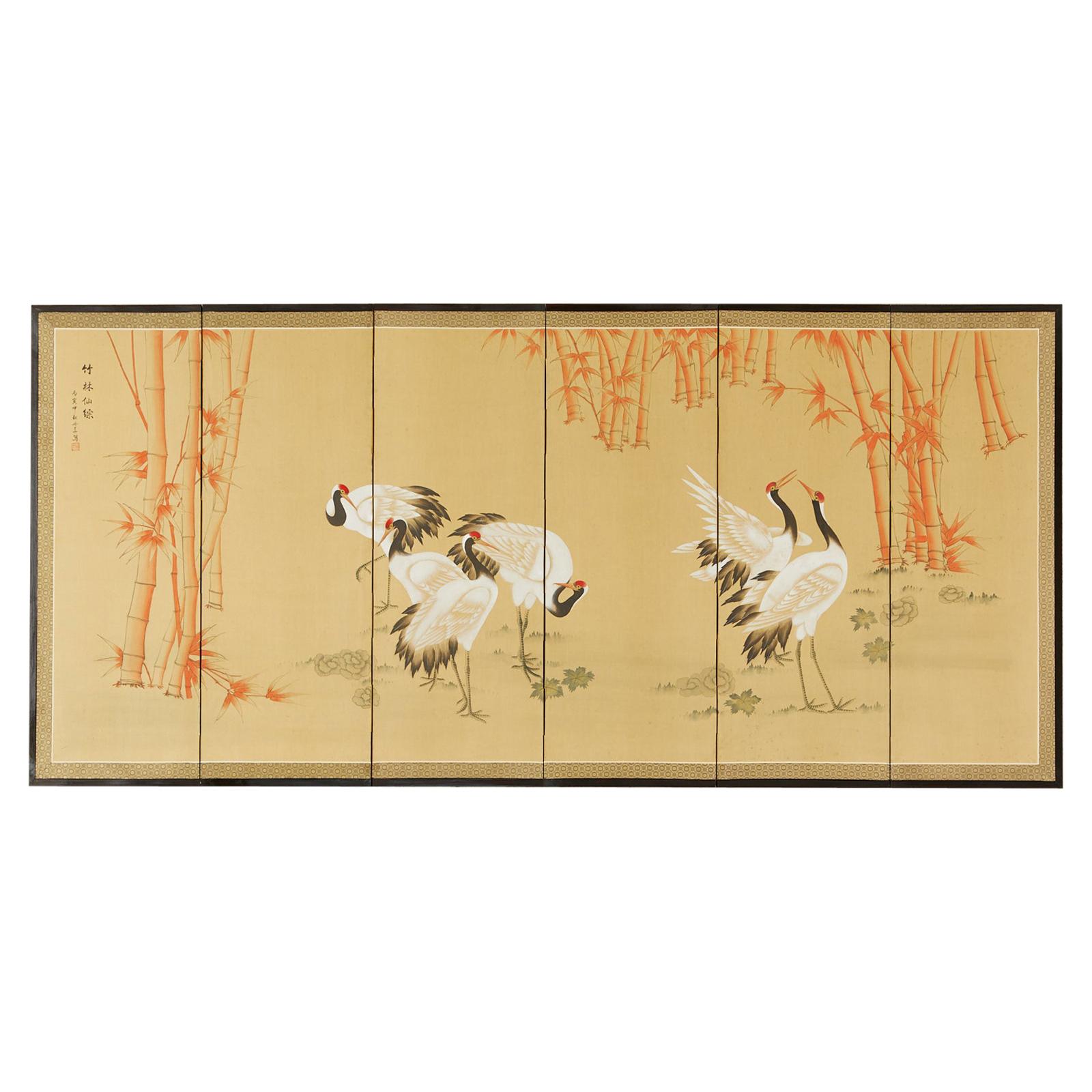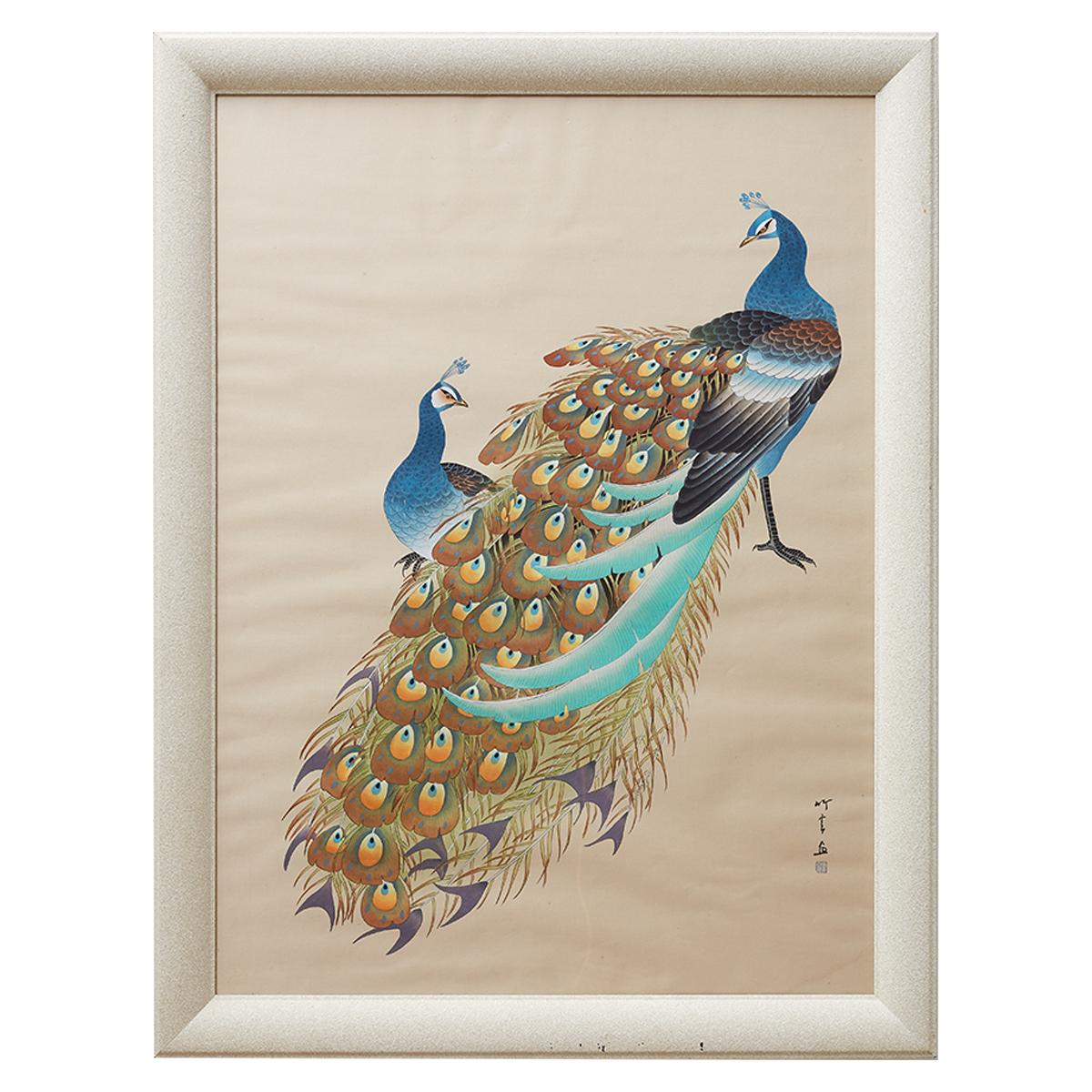Items Similar to Japanese Screen Painting, Cat & Pumpkin Patch. Showa Era, 1940s
Want more images or videos?
Request additional images or videos from the seller
1 of 5
Japanese Screen Painting, Cat & Pumpkin Patch. Showa Era, 1940s
About the Item
Chuichi Konno (1915-2006)
Cat and Pumpkin Patch
Showa period, 1940s.
Folding screen in two-panels. Painted on paper with mineral pigments and gofun.
Sign: Chuichi
Seal: Konno no in
Dimensions:
H. 136 cm x W. 166 cm (53.5” x 65”)
A two-fold Japanese screen from the 1940s by the Nihonga artist Konno Chuichi, depicting a cat grooming itself amidst a flowering pumpkin patch. Rather than the geometric formality often encountered in the mid-1930s, here the artist utilizes fluid line and pattern to express the density of the foliage. The somewhat abstract and simplified shapes and saturated colors generate the impression of a field constructed entirely of captivating pattern. Generous use of both mineral pigments and white powdered shell (gofun), built-up to create a slightly three-dimensional effect, is apparent throughout the entire work.
Chuichi originally studied traditional Nanga style painting in his home prefecture of Yamagata. He left for Tokyo soon after the death of his teacher, Goto Shotei, in 1934. There he continued his studies under the modern landscape artist Kodama Kibo. He changed direction quite dramatically in 1940 after being inspired by the work of Gokura Senjin. Chuichi joined his atelier and began formulating his personal style, which culminated in the 1950s and 1960s in densely composed forest and mountain views depicted with heavily applied pigments. Chuichi exhibited on with the Inten on 42 occasions and received the highest award there. He was a councilor, and later the director of, the Japan Art Academy. He taught at the Aichi University of Arts and was an honorary professor at the Tohoku University of Art and Design.
- Dimensions:Height: 53.5 in (135.89 cm)Width: 65 in (165.1 cm)Depth: 0.75 in (1.91 cm)
- Style:Showa (Of the Period)
- Materials and Techniques:
- Place of Origin:
- Period:
- Date of Manufacture:1940s
- Condition:Refinished. The screen has recently been conserved and fully remounted in Kyoto utilizing traditional techniques and craftsmen.
- Seller Location:Kyoto, JP
- Reference Number:1stDibs: LU2472316403741
About the Seller
5.0
Recognized Seller
These prestigious sellers are industry leaders and represent the highest echelon for item quality and design.
Gold Seller
These expertly vetted sellers are highly rated and consistently exceed customer expectations.
Established in 2001
1stDibs seller since 2016
59 sales on 1stDibs
Typical response time: 5 hours
- ShippingRetrieving quote...Ships From: Kyoto, Japan
- Return PolicyA return for this item may be initiated within 10 days of delivery.
More From This SellerView All
- Meiji Era, Circa 1900 Japanese Screen Pair, Flowers & Birds of Spring & AutumnLocated in Kyoto, JPFlowers & Birds of Spring and Autumn Unknown artist. Japan. Meiji period, circa 1900. A pair of six-fold screens. Ink, color, gofun and gold leaf on paper. Signed: Gaga S...Category
Antique 1890s Japanese Meiji Paintings and Screens
MaterialsGold Leaf
- Japanese Screen Painting, circa 1700 'Horses' by Kano TanshinLocated in Kyoto, JPHorses Kano Tanshin Morimasa (1653-1718) Two-panel tea-ceremony Japanese screen or furosaki Ink on gold leaf, late 17th-early 18th century Measures: H 55 cm x W 182 cm The Kano school was closely aligned with the warrior class in Japan. The samurai, who lived in a closed and rigid hierarchical society established by the Shogunate, were drawn to the energy and freedom horses symbolize; Kano school artists commonly depicted the equine creatures as they are here, in unfettered and carefree family groups. China originally introduced horse paintings to Japan; the works typically focused on capturing the essence of horses in their various environments and often involved integrating human figures into the images. Kano Tanshin Morimasa (1653-1718) was the son of Kano Tanyu...Category
Antique 1690s Japanese Edo Paintings and Screens
MaterialsGold Leaf
- Japanese Framed Silk Painting, Turtledoves and Peaches, Taisho Era, circa 1920Located in Kyoto, JPNakamura Daizaburo Turtledoves in a Peach Tree Taisho period, circa 1920 Framed painting. Mineral pigments, ink and gofun on silk Signed: Daizaburo Dimensions (framed)...Category
Vintage 1910s Japanese Taisho Paintings and Screens
MaterialsWood, Silk
- Japanese Painting, Framed Panel, Willow and Sparrows, circa 1920 Taisho eraLocated in Kyoto, JPAnonymous Summer willow and sparrows Taisho period, circa 1920 Framed painting. Mineral pigments, mica, gold, ink and gofun on silk Dimensions (framed): H. 98 cm x W. 135 cm x D...Category
Vintage 1920s Japanese Taisho Paintings and Screens
MaterialsWood, Silk
- Early 20th Century Japanese Cherry Blossom Screen by Kano SanrakukiLocated in Kyoto, JPCherry Blossoms Kano Sanrakuki (1898-1981) Showa period, circa 1930 2-panel Japanese Screen Color, gofun and gold leaf on paper Against a backdrop of gold-leafed ground, the lichen covered trunk and branches of the life-sized cherry blossom tree reach out and beyond the confines of the pictorial surface. The overall composition has a feeling of flatness which draws emphasis to the surface and the three-dimensionality of the cherry blossoms. Painstakingly built-up layers of thickly applied shell-white gofun detail the voluminous blossoms and cover large areas of this tour-de-force of Japanese Nihonga painting. By simplifying the background, minimizing the number of colors and depicting the blossoms with such heavy relief, the artist has emphasized the stunning presence of the cherry tree. The type of tree depicted is the Yae-Zakura; a double-layered type of cherry blossom famed for its beauty and strength. When we think of Japanese cherry blossoms, the first thing that comes to mind is Somei Yoshino variety, which has a single flower with five almost white petals. This type is fragile and easily blown away by strong wind or rain. Most of the double-flowered cherry blossoms begin to bloom when the Somei-Yoshino falls, and the flowering period lasts longer than that of the Somei-Yoshino. Kano Sanrakuki originally studied painting at the Kyoto City Arts and Crafts School under the tutelage of Yamamoto Shunkyo...Category
Early 20th Century Japanese Showa Paintings and Screens
MaterialsGold Leaf
- Japanese Painting, Hanging Scroll, 'Playful Cat' by Hirose Toho, 1920s TaishoBy Hirose TohoLocated in Kyoto, JPPlayful Cat Hirose Toho (1875-1930) Hanging scroll, ink, mineral pigments and gofun on silk. Painting inscription: Toho Sha Painting seals: Upper - Hirose Hitoshi Lo...Category
Vintage 1920s Japanese Taisho Paintings and Screens
MaterialsSilk
You May Also Like
- Japanese Showa Two Panel Screen Blossoming Prunus TreeLocated in Rio Vista, CASerene Japanese Showa period two-panel folding byobu screen depicting a large spring blossoming prunus tree or plum tree. Beautifully painted with ink and natural color pigments on m...Category
20th Century Japanese Showa Paintings and Screens
MaterialsBrass
- Japanese Showa Six Panel Screen Manchurian Crane Bamboo GroveLocated in Rio Vista, CAEnchanting Japanese Showa period six-panel byobu screen titled "Bamboo Forest-Immortal Together". The large screen depicts six manchurian cranes in a ...Category
20th Century Japanese Showa Paintings and Screens
MaterialsBrass
- Japanese Showa Period Peacocks Painted on SilkLocated in Rio Vista, CAColorful Japanese ink and color on silk Showa painting of a pair of peacocks. Vivid colors and beautiful details with a signature and seal on right side bottom. Framed in a midcentur...Category
20th Century Japanese Showa Paintings and Screens
MaterialsSilk, Plexiglass, Paper, Wood
- Korean Showa Four Panel Screen Tartars Hunting LandscapeLocated in Rio Vista, CAMagnificent Korean Showa period four-panel screen depicting hunting scenes with tartars in a mountain landscape. The screen is decorated with vibrant ink and natural color pigments o...Category
20th Century Korean Showa Paintings and Screens
MaterialsBrass
- 20th Century Showa Period Beautiful Spring Garden Folding Screen Two PanelsLocated in Brescia, ITJapanese screen with two doors painted with mineral pigments on rice paper. Early Showa period.Category
Late 20th Century Japanese Showa Paintings and Screens
MaterialsPaper
- Japanese Two-Panel Screen Spring FlowersLocated in Hudson, NYA vibrant celebration of spring using a colorful ensemble of coxcomb, irises, lilies, hybiscus, and a blossoming cherry tree. Great examples of "tarashikomi" or "painting-in", a Rim...Category
Vintage 1930s Japanese Showa Paintings and Screens
MaterialsSilk, Paper
Recently Viewed
View AllMore Ways To Browse
Modern Screens
No Era
Furniture From The Modern Era
Three Screen
Japanese Inspired Furniture
Wood Screens Modern
Cat Wood
Asian Paintings On Wood
Japanese Paper Painting
Japanese Paint Screen
Japanese Painted Screen
Vintage Japanese Pattern
Vintage Japanese Patterns
Japanese Wood Painting
Traditional Asian Painting
Japanese Mountain Furniture
1940s Japanese
Panel Screens Modern





